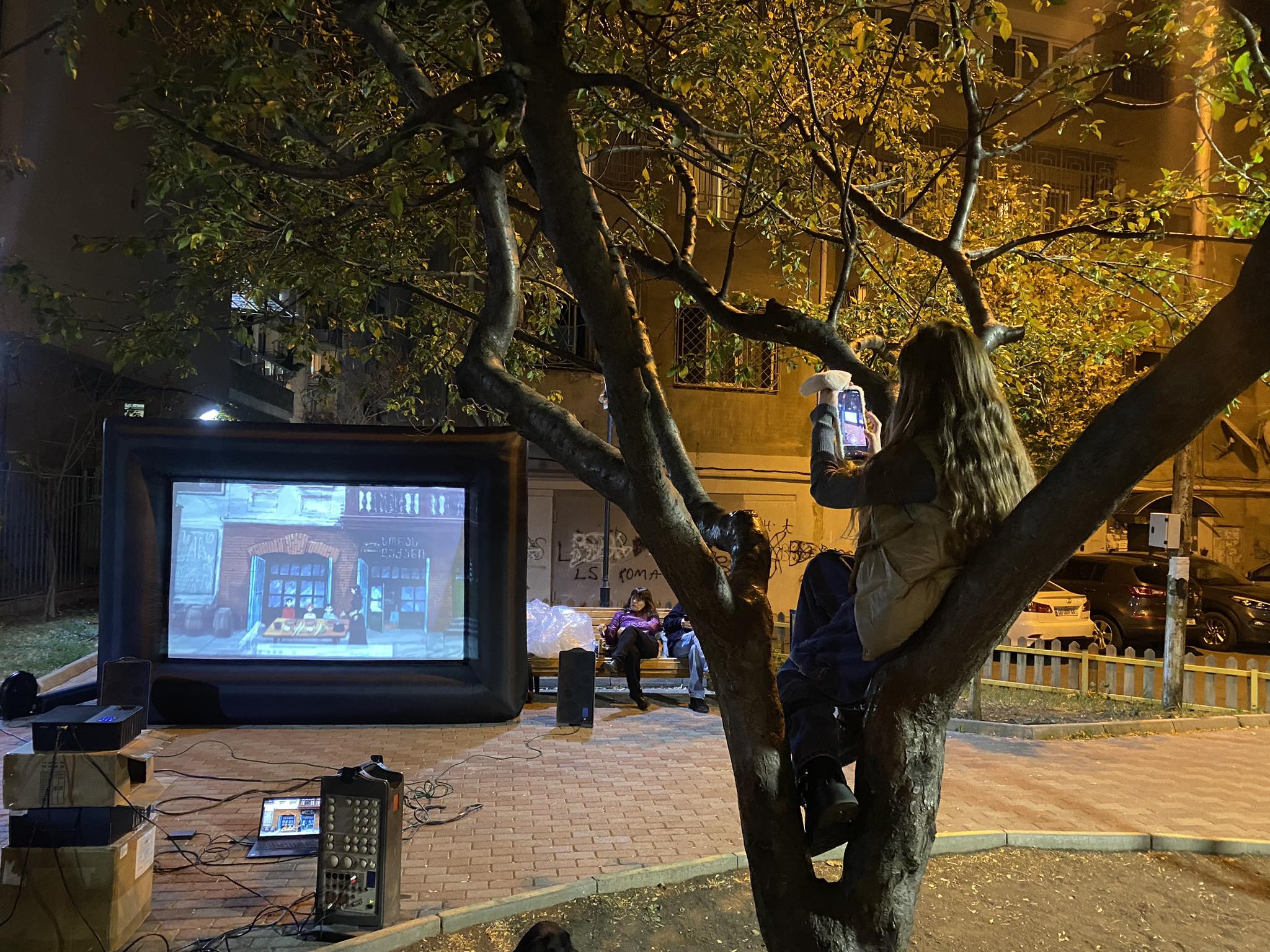Dear Audience, Who Are You?
FIND YOUR COMMUNITY AND NEVER LET IT GO
AUTHOR: Dina Pokrajac, Dokukino KIC Manager (Restart, Croatia)

The following chapter will summarize the experience with community screenings for various audiences at Dokukino in Croatia. Our program is primarily defined by current societal events. It consists of films that address socially and politically relevant themes (e.g., gentrification, degrowth, ecology, migration, colonial legacy, the defense of the commons, sex and gender equality, social change, questions of democratization and participation, the media and public sphere, and alternative economic models) in an artistically accomplished and innovative way. We embrace controversial and delicate topics and encourage dialogue through documentary film screenings followed by moderated discussions—different opinions are welcomed, and we stimulate open critical thinking.

We extensively cooperate with civil society organizations and experts from various fields, including political science, sociology, philosophy, ecology, anthropology, history, and economy. In this way, we want to contextualize themes that certain documentaries cover in a broader interdisciplinary way. We often receive backlash on social media from members of the opposite political spectrum for certain films we screen, especially the ones dealing with Yugoslavia and the former socialist regime or disputed historical events. These are still painful subjects in our society, and unfortunately, collective memory is constantly being erased and rewritten. However, for us, art is always political, and it is our duty to initiate debates about controversial topics. Documentaries help people open their minds and develop empathy and understanding.
The Curator’s Choice
“I’m not going to say it’s easy because it’s not. It requires a lot of effort, and it only takes one film (which you thought would be interesting) to lose your audience forever. I think one needs to maintain a good program, constantly bring in new things and try one’s best. The most rewarding experiences are when, after seeing the film, people come, still under the impression, to say thank you. That is when we see a purpose and a meaning in everything we do.”
Ana

The first thing a film curator needs to do is to define the audience they are addressing. Sometimes, when we want to reach out to everybody, we become painfully aware we are reaching out to nobody. You will never be able to please everyone, and it is OK that the first viewer you aim to please is yourself. The curator deals with two conflicting approaches. On the one hand, we want to cultivate a broad and diverse audience. On the other hand, certain films and topics will address particular audiences and niche tastes.
Film curators will be respected by cinephiles for their film knowledge and exquisite taste, but at the same time, they must remain accessible to a less sophisticated audience with a sporadic interest in documentary films. The latter come to the screening only because they are interested in a specific topic or because your successful PR campaign spurred their curiosity.
Your goal is to make the screening a gratifying experience so they return to your venue or events. Of course, biographical and musical documentaries are always very popular. Viewers of documentary films are still predominantly thematically oriented, and they don’t necessarily perceive a documentary as a legitimate art form—it is our task to change their minds.

And now, identify important and urgent topics (often omitted by other cultural events) in your community and try to find documentaries that address them in a relevant and artistically stimulating way. You can think of a topic yourself, brainstorm it with your team, ask people around, or follow current events in the media and on social media.
The KineDok catalogue is a good start. For instance, Taming the Garden is one of my personal favorites of 2021 and an example of combining all three audiences with a challenging film. This visually stunning cinematic poem appeals to cinephiles but also attracts a broader thematically oriented audience because of its edifying tale about the resilience of nature and the insatiability of human greed (in recent years, our viewers have been particularly interested in ecological topics, especially the younger ones).
Don’t underestimate your audience or pamper their every whim, but don’t be a pretentious snob, either. Recognize when to play it safe and schedule a feelgood film, a festival darling, or a film made by a popular local travel blogger. Still, your program must have a recognizable signature, so don’t hesitate to make bold and daring creative decisions in your film selection. However, you should also strive to be inclusive and open to suggestions from the community (our viewers reach us through emails, social media comments or answers to occasional questionnaires we give out after screenings).
Cinema as a Living Room
Always keep in mind that coming to watch documentaries is a social event. At Dokukino, our main aspiration is to screen current documentaries in a cozy and intimate atmosphere and turn our cinema into a living room—with comfortable chairs and direct contact with the filmmakers and the creative team behind the project. We communicate with our visitors on a regular basis and readily respond to all their comments and suggestions.
We often receive messages from audience members saying, “You should screen this” or “That was a fantastic evening”. It sounds like a cliché, but people can tell when you love what you do, and if you don’t like the place where you work, everyone else will feel it, and no one will come. It is important for us that people enjoy coming to our cinema, asking our team questions, and taking part in events.

Sometimes, small gestures make them feel welcomed and at ease; for instance, we encourage our viewers to bring drinks from the bar or their own snacks to the screening room. As we are a dog-friendly cinema, we always have some dog bowls filled with water and goodies lying around so their pets can enjoy the trip to the cinema as well. Also, make sure your staff talk to the viewers and engage them in comprehensive and substantiated conversations on all film-related topics. And don’t become self-defensive when confronted with criticism—even the Karens of this world have something worthwhile to share.
Don’t Just Screen Films, Provide an Experience
How to spark the public's curiosity?

How to spark the public’s curiosity remains the greatest challenge. Let’s face it: a film of superb quality and timeliness often isn’t enough to capture its attention. We cannot just screen films; we need to provide an experience. Film premieres at Dokukino are almost exclusively accompanied by talks with the film crew, panel discussions related to the film’s topic, or other special events.
For each new film, we specifically target our audience; apart from regular advertising and promotion, each month, we organize specific promotional campaigns in which we use communication channels and promotional tools appealing to the particular audience in question. We target cinephiles, but also, for each film, we build an outreach network and contact NGOs, associations, brands, and media that are specifically related to the theme the chosen documentary film explores.

For example, for the film King Skate, we reached out to skaters and the punk scene (we contacted local skating clubs and alternative clubs like Mochvara; we even found out that there is a Vladimir Skate Film Festival organized in Istria every year). On the other hand, for Palace for the People, we contacted local architects, urban anthropologists, urban planners, and students of design and architecture. We built a whole program around it called Architecture and Memory with a panel discussion involving experts and other film titles.
When we screened Solo, we organized a conversation with piano teacher and child prodigy Virna Kljaković and psychiatrist Hrvoje Handl, who shared their experiences with us, providing added value to our audience. We also reached out to music schools and the University Psychiatric Hospital Vrapče, which organizes a film-discursive program called Film and Psychiatry for their students and interns in cooperation with the Croatian Film Critics Society.
We strive to celebrate film culture but also promote a cinema-going culture. To achieve this goal, we organize a varied events program but also try to maximize the spaces and create additional rooms to the cinema hall—a café to host post-screening discussions, workshops, and talks, a bookstore to buy film magazines and publications, an exhibition space for video-installations, film posters and photographs, open mic sessions to review films or discuss new releases, and many more.

The audience attendance usually starts dropping in June—this is why, from the beginning of July until the second half of September, we organize open-air screenings at Art Park Zagreb, a green oasis in Zagreb’s city center and a perfect place to chill during the hot summer months. In 2023, we did Doksi u Kleti, a series of very successful screenings at Klet, a revitalized space occupied by emerging local artists and cultural professionals. We find our allies to get the audience’s attention for creative documentaries and topics we want to address in local artists, activists, artisans and grassroots initiatives, while the film screenings become part of a wider range of events (concerts, workshops, street art, flea markets). For instance, Plastic Free July is a great initiative which helps us screen environmental documentaries in collaboration with local NGO Zelena akcija.

source: xxx

source: xxx

source: xxx

7 Practical Tips to Help You Tend to Your Audience
1. Follow current events, identify socially and politically relevant topics and encourage debate.
2. Make bold and creative programming decisions, and never underestimate your audience.
3. Involve the community and be open to their suggestions—diversify your program and encourage them to participate.
4. Do small gestures to make your audience feel comfortable so they return to your venue or screenings.
5. Don’t just screen films; provide your audience with a memorable and enjoyable experience.
6. Build an extensive outreach network and target your audience specifically for each new film with personalized and original digital marketing.
7. Provide your audience with additional activities (workshops, performances, exhibitions, concerts, etc).
Notes and Sources
PHOTOS:
BISTRIČIĆ, Sanja; ŠARLIJA, Zoe; MAGZAN, Anto; PLANINC, Borut, BERDAIS, Klara and Leonardo KLANCIR
Archive of our screening venue (Dokukino)
We live the documentary film, be there with us.
Start each month with a fresh dose of information. Subscribe to the newsletter.
I hereby consent to the processing of the personal data.










